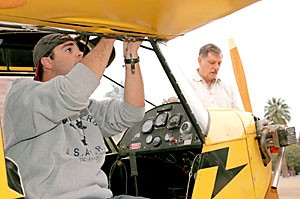“”We’re not just for pilots. Anyone with an interest in flying and aircraft is welcome to join.”” – Viral Shah, engineering management senior and treasurer of the club
Most students are used to seeing campus clubs set up tables on the UA Mall, but they may have been surprised by the mysterious appearance of an airplane yesterday morning.
The school-bus-yellow 1970 N3 Pup ultralight aircraft was assembled on the Mall near the Krutch Cactus Garden in the early hours by members of the UA Flying Club after they spent almost two hours removing the wings and loading the pieces into a moving truck.
“”It’s not too heavy; the frame is almost entirely steel tubing and fabric,”” said David Hahs, an aerospace engineering senior and president of the club. “”It’s all very rudimentary technology of the ’30s and ’40s. The wings only weigh about 20 pounds each.””
The plane belongs to a friend of flying club faculty member Stephen Kukolich, who allowed the students to move the plane from its hangar at Ryan Airfield, 9700 W. Ajo Way, to help recruit new members.
“”This really is the perfect attraction,”” said Viral Shah, an engineering management senior and treasurer of the club. “”We had a booth on the Mall last semester, but having a plane out here really gets people’s attention.””
Shah said most of the people were asking if someone had landed the plane on the Mall, while others wondered whether the plane was some sort of historical monument.
“”I saw this plane and thought, ‘That looks pretty cool,'”” said Adam Sandifer, an engineering management senior who stopped to check out the plane and the club. “”I wanted to know if someone actually flew in that. That would take some balls.””
But regardless of what brought them to the plane, Shah was hopeful the stunt would increase the club’s dwindling membership.
“”There was a time where we had a lot more members; over 100,”” Shah said. “”Now we are down to about 20. More members mean we have more funding for activities.””
Those activities include guest speakers for the club’s Monday-night meetings, including A-10 pilots from Davis Monthan Air Force Base and Tucson Police Department helicopter pilots.
Fees for these speakers, as well as for other club events like “”fly outs”” and parties, come primarily from the club’s $20-a-year membership dues, Shah said.
He said many were also curious about whether someone needs to be a pilot to join the club.
“”We’re not just for pilots,”” Shah said. “”Anyone with an interest in flying and aircraft is welcome to join.””
Shah is one of the many club members who do not currently hold a pilot’s license, but said he thinks his experiences in the club will help him pass his certification after he graduates in May.
“”I didn’t know much about planes and all the gauges and equipment,”” Shah said. “”But after two years in the club I’m more familiar with everything. It’s helped me learn a lot easier.””
Kathryn Gardner, a planetary sciences doctoral student and club member who has her private pilot’s license, said the club has also been helpful for students who are experienced pilots.
“”We do a lot of sharing,”” Gardner said, referring to the club’s ride-share Listserv, where members can arrange flights together and split the costs of plane rentals and fuel.
Gardner is currently training for her instrument certification, an advanced license that permits a pilot to fly in more adverse conditions.
“”The hardest thing about getting your instrument rating is you need to build up 50 cross-country in-command hours,”” Gardner said. “”It’s nice to have another person with you, and it’s safer.””









